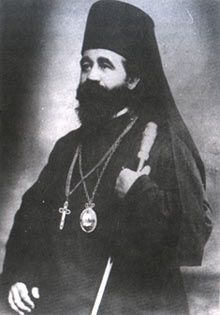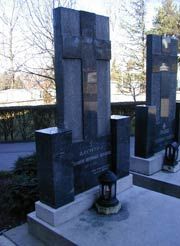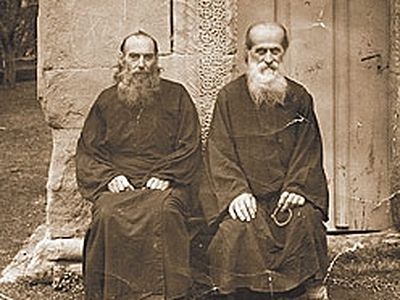 Holy Confessor Dositheus
Holy Confessor Dositheus
After the Yugoslav defeat in 1941, an Independent Croat State was proclaimed in Zagreb. Before the war its territory had been populated by some five million Roman Catholics, mainly Croats, some two million Orthodox Serbs and about 750,000 Muslims.
After the entry into Zagreb of German troops, welcomed by flowers and singing, on 13 April 1941 there arrived the leader of the Fascist Croat Ustashi, Ante Pavelich. The next day he received the visit of the Catholic Archbishop Aloysius Stepinac, who greeted him and blessed him as the head of the new State. At that time local newspapers published instructions, according to which the Orthodox Serb population had to quit the capital of Croatia within twelve hours and anyone who had hidden Orthodox was threatened with arrest. At Easter 1941, blessing Ante Pavelich in the name of the Vatican, Archbishop Stepinac of Zagreb said: ‘I sincerely congratulate you as head of the Independent Croat State, we pray that the God of Heaven may send down his celestial blessing on you, the leader of our people’ (1).
Vatican support was extremely important for Pavelic. On 18 May 1941 he went to Rome with a large Ustashi delegation, in order to give the crown of Croatia to Tomislav II, with the blessing of the Vatican. Pope Pius XII received the delegation and had a lengthy conversation with Pavelic. Afterwards Pavelic met Mussolini (2).
From the first days of the existence of the Independent Croat State, there began beatings, arrests and the deportation of the Serb population from the towns and to concentration camps. With the arrival of Pavelic in Zagreb, the anti-Serb terror campaign took on a ‘legal’ aspect. Twelve days after his arrival in Zagreb, Pavelic issued instructions that the Cyrillic alphabet was to be forbidden. On 3 June 1941 all Serbian schools, educational institutions and orphanages were abolished. Orthodox Serbs in Zagreb and other towns were forced to wear an armband with the Latin letter R on them. The name of every town and village which had the word ‘Serb’ in it was changed to ‘Croat’.
All property belonging to the Serbian Church in Sremski Karlovtsy was expropriated in the name of the State. On 18 June 1941 a statement was issued declaring that the term ‘Serbian Orthodox Faith’ did not accord with the new State structure and the term ‘Eastern Greek faith’ was to be used in the future. These and other harsher measures regarding the Serbian people were publicized by the Ustashi leaders and State activists. One of them, Mile Budak, publicly stated in the Zagreb Parliament that a third of the Serbs were to be annihilated, a third to be deported and a third to be made Roman Catholic and thus be assimilated with the Croats.
About this period Bishop Athanasius Yevtich has written: ‘The Serbian Orthodox Church, like the whole Serbian people, was at that time outlawed. The only law which operated with regard to the Serbs was the law of total annihilation. The adherents and advocates of the Ustashi ideology understood perfectly well the importance of the Orthodox Church for the Serbian people’. The well-known Serbian writer Marko Markovich rightly confirms that nothing, ‘could alter the conviction of the Ustashi that the Serbian Orthodox Church was the first thing to be uprooted and destroyed on the territory of Pavelic’s Croatia'.
Among the first victims of the Ustashi was Metropolitan Dositheus (Vasich). of Zagreb. One of the most famous, best educated and respected bishops of the Serbian Church. Vladyka Dositheus was the first Orthodox Metropolitan of Zagreb, having been appointed tin 1932. He brought with him a wealth of experience as a bishop.
Born and brought up in Belgrade, after finishing seminary in 1900, he won a scholarship to the Kiev Theological Academy. In 1904, a hieromonk, he graduated from the Academy with a doctorate. After this the future bishop went to Germany, where he studied theology and philosophy for two years at the University of Berlin and then for two more years in Leipzig. He returned to Serbia in 1907 and taught at the St Sabbas seminary in Belgrade. With a bursary from the Ministry of Education in Belgrade, in 1909 Fr Dositheus headed for France. Here he studied philosophy and social sciences at the Higher School of Social Sciences in the Sorbonne. In 1910 he went to Switzerland, where he was living at the outbreak of the First Balkan War in autumn 1912. The hieromonk returned to Serbia and gave himself up wholeheartedly to the cause of the freedom and unity of the Serbian people.
In May 1913 the Council of Bishops of the Kingdom of Serbia appointed him Bishop of Nish. With the outbreak of the First World War the young bishop supported the soldiers spiritually and laboured to help refugees and orphans. When the Serbian Army retreated, he did not leave his residence and when Nish was occupied, he was interned by the Bulgarian forces of occupation. He managed to return to his see only in 1918. His health was seriously affected by his imprisonment. On his return, he set up orphanages, worked a great deal with young people and founded charities. He set up an orphanage for blind children in one of the monasteries of his diocese. Through his efforts, several memorials were put up in memory of the heroes of the nation, who had sacrificed their lives for the freedom of their homeland.
After the First World War the new State of Yugoslavia took shape and conditions were favourable for the reunion of Serbian dioceses and metropolias into one Church. Bishop Dositheus took part in negotiations with the Patriarchate of Constantinople regarding the restoration of the Patriarchate of Serbia. These were successful, and on 12 September 1920 the reunion of the Serbian Orthodox Church and the restoration of the Patriarchate were triumphantly proclaimed in Sremski Karlovtsy
On 1 December 1920 the Council of Bishops of the Serbian Orthodox Church decided to send Bishop Dositheus to Czechoslovakia, at the repeated requests of Carpatho-Russians, Czechs and Slovaks. On 21 August 1921 Bishop Dositheus went to Subcarpathian Russia and visited the centre of Orthodoxy in the area, the village of Iza, where he was welcomed in triumph. Then Vladyka visited several villages and officiated. Visiting the town of Velikie Luchki, Vladyka received three Uniat schoolteachers into the Church. A meeting took place, chaired by the Bishop, at which delegates from sixty Orthodox villages discussed priorities for the organization of a Carpatho-Russian Church. The meeting resolved that the delegates should ask the Very Reverend Bishop Dositheus not to leave the Carpatho-Russian Orthodox Church without his care and commit to him the governance of the affairs of this Church until the definitive canonical resolution regarding the Eastern Orthodox Church in Carpatho-Russia. A constitution for the new Church was drawn up and Bishop Dositheus went to Prague for it to be approved at the Second Council of the Church of Czechoslovakia on 28 and 29 August 1921.
When this Council was over, Vladyka went to Serbia and took part in the Council of Bishops at which he gave a talk about the situation of Orthodox in Czechoslovakia and Subcarpathian Russia. Bishop Dositheus played a particularly important role in the rebirth and organization of the Orthodox Church on Czechoslovak territory. However, in 1932 he was appointed to the recently founded Diocese of Zagreb. Nevertheless, Vladyka did not forget his flock in Czechoslovakia. On 29 September 1935, the feast-day of St Wenceslas, the patron-saint of Czechia, Metropolitan Dositheus took part in the consecration of the Cathedral of Sts Cyril and Methodius in Prague. He returned to Czechoslovakia in 1939 and took part in the consecration of the new Orthodox Cathedral in Olomouc.
In the Croat capital, where Orthodox Serbs were a minority, Vladyka soon had problems with national and religious intolerance. This is what the Carpatho-Russian political and religious leader Alexis Gerovsky had to say about this: ‘The Catholics were very dissatisfied when Vladyka Dositheus was appointed to Zagreb. His name had already been blacklisted, because, ‘he had made Carpatho-Russians Orthodox with his propaganda’, as could be read in the supplementary volumes of the official ‘Catholic Encyclopedia’, as published by Cardinal Spellman in New York. When, a few years before the outbreak of World War Two, Vladyka told me that he had been appointed to Zagreb, I urged him not to accept, since he had never been there and was not acquainted with the religious fanaticism of the Zagreb Croats. Among other things, I told him about Stepinac, who was already notorious for his intolerance, and warned him that he would have a lot of trouble there. I told him: ‘Stepinac spent seven years in the Jesuit seminary in Rome and will be offended by the presence of an Orthodox Metropolitan in his capital’. I advised him to persuade the members of the Synod to send a bishop who had been born before the First War, had been brought up in the Austro-Hungarian Empire and who was already familiar with people like Stepinac. But Vladyka answered that it was his duty to obey the Patriarch and go to Zagreb.
When, a few months later, I met Vladyka in Belgrade, he told me that I had been right. He was often insulted in the street. Sometimes they would break his windows in the night. Stones even fell into his bedroom. I asked whether he had contacted the police. He answered that it was not fitting for a bishop to call the police. But when I told him that in that case his enemies would think that he was frightened of them and that they would grow even more insolent, Vladyka answered: ‘No, they know that I’m not frightened of them. When they swear at me or spit at me, I simply raise my hand and bless them''.
Vladyka was very, very active in Zagreb. Among other things, he founded a convent dedicated to St Paraskeve. However, immediately after the Independent Croat State was proclaimed, he was arrested by the Ustashi. On that day he was ill and lying in bed. Half-dressed, he was taken out onto the street in front of a Catholic mob. Led around the streets of Zagreb, the mob mocked him and beat him. By the time he was taken to hospital, he was almost unconscious.
 Holy Confessor Dositheus' grave in the cemetery of the Monastery of the Presentation in Belgrade
Holy Confessor Dositheus' grave in the cemetery of the Monastery of the Presentation in Belgrade
The hospital that Vladyka was taken to was run by Catholic nuns. This became for him not a place of treatment, but a real prison. Instead of caring for him, the nuns mocked him. Nearly every day they scourged him and pulled out nearly every hair of his beard. After a time, seriously ill, he was taken to Belgrade. According to one of the prison doctors there, one day, two SS guards in uniform brought to the prison surgery a man dressed in rags, breathing heavily and unable to speak. His body was covered in bruises and haemmorages. The Germans said that they had found him in a police cell in Zagreb and, discovering that he was a Serbian bishop, decided to bring him to Belgrade.
At the insistence of the Serbian government, Bishop Dositheus was released from hospital. Very ill, he arrived in Belgrade and received constant medical treatment. However, on 14 January 1945 he died as a result of the torture he had endured and he was buried in the cemetery of the Monastery of the Presentation in Belgrade.
Translated by Fr Andrew Phillips
Translator’s Notes:
1. Beatified (!) by Pope John Paul II in 1998. There is no doubt that Archbishop Stepinac saved many Jews from the Ustashi, but this beatification, given the passiveness of the Croat Archbishop during the Ustashi genocide of the Serbs, the greatest religious massacre until the genocide committed by Catholics in Rwanda some fifty years afterwards, merely discredits Catholicism.
2. Mussolini, for those who have forgotten, wrote such things as this: ‘We do not believe in programmes, plans, saints or apostles, we do not believe in happiness, salvation or the promised land’ (Fascism). ‘It was only one life. What is one life in the affairs of a State?’ (Said in 1931, after he had run over a child in his car).
3. On the bloody persecution of the Serbian Church in Vatican-backed Croatia and the up to 700,000 victims of the Roman Catholic massacre there, see the illuminating if depressing book by the Protestant author Avro Manhattan, especially The Vatican’s Holocaust (Ozark Books, 1986 and 1988). We particularly recommend this to those naive Catholics in Western countries, who have no idea what the leaders of their Church got up to during the Second World War in their name. The savagery of Roman Catholic clergy and laity at that time goes beyond even their animal barbarity during the Crusades 700-800 years earlier or in Mexico 400 years earlier.
4. On Carpatho-Russia, its sufferings and those of Bishop Dositheus, see the articles under ‘Orthodox Carpatho-Russia’ on this site.



